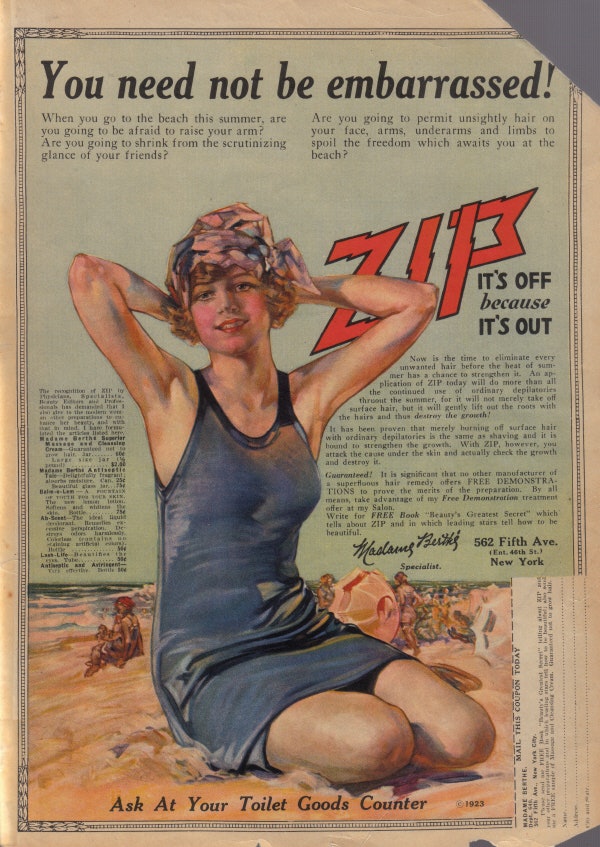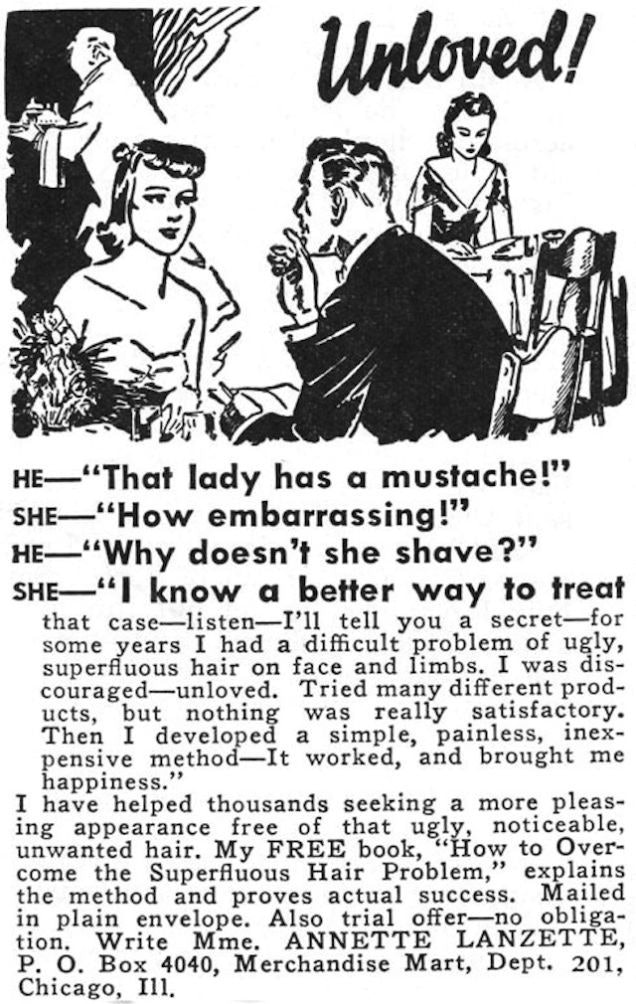‘I shave my whole body every day. It’s exhausting. Trust me. It’s gotten to the point where it takes up more of my life than anything else.’ – Chrissy Teigen in Allure, April 2015
‘I refuse to shave. I had hairy armpits … The boys in my school would make fun of me. “Hairy monster.” You know, things like that.’ – Madonna in Harper’s Bazaar, November 2011
‘[I]f we never told girls to shave, would they? If we modeled a cultural acceptance of our body hair, would they spontaneously feel the need to remove it [?]’ – Mayim Bialik in Kveller, July 2012
Even though body hair removal goes back centuries, in its most recent evolution female body hair has been equated with societal shame.
So do we shave because we genuinely want to, or are we simply subject to the pressure society places upon us women to remove our body hair?
Either way; what is common practice among most girls and women today was virtually nonexistent less than a hundred years ago – so much so that a girl accidentally cutting her leg while shaving elicited an article in the newspaper.

Yet only ninety years later, in 2016, a study found that 77% of UK women shaved their underarm hair and 84% were removing their leg hair, arguably posing the question of what elicited this drastic shift.
Answer: the beauty industry.
The Birth of Women’s Razors
With the first disposable razor for men introduced in 1903, Gillette sold more than 90,000 sets in 1904 alone. In an effort to expand their market share, Gillette, together with women’s magazines and the fashion industry, campaigned to convince women that female body hair was undesirable.
When the first razor exclusively targeted toward women was made available by Gillette in 1915, advertisements ran primarily in women’s magazines and estimated advertising spends increased from approximately $200 million in 1890 to more than $600 million.
One of the first advertisements promoting female hair removal was run in the 1915 May Issue of Harper’s Bazaar, advocating for the ‘necessary . . . removal of objectionable hair’. Targeting ‘women of refinement’, the ad functions as a prime example of manipulative language.
Subsequent advertisements similarly used language to shame women into removing their body hair. A 1922 ad stated that the ‘fastidious woman must have immaculate underarms if she is to be unembarrassed’, repeatedly reinforcing the humiliation women would be subject to if not removing their ‘superfluous hair’ to make way for ‘smooth, unblemished skin’.

Hair removal advertisements over the following decades all shared the common theme of associating shame with female body hair. An ad published between the 1920s and 30s implied that ‘the freedom which awaits you at the beach’ is exclusively attainable for women without ‘unsightly hair on . . . face, arms, underarms and limbs’, supported by an image of woman in a short dress, happily presenting her clean-shaven armpits and legs.

An advertisement from the 1930s goes a step further, suggesting that hairy women are inherently unworthy of love. The ad – subtly titled ‘Unloved!’ – features a man and a woman discussing a lady’s ‘embarrassing’ moustache. Yet the woman admits that she too struggled with ‘ugly, superfluous hair on face and limbs’, declaring: ‘I was discouraged – unloved’. However, the advertised hair removal method helped her to attain a ‘pleasing appearance free of that ugly . . . hair’, finally bringing ‘happiness’.

A Growing Issue
As Joan Brumberg, author of The Body Project, notes: ‘[H]air removal was promoted as a gender norm requirement for women, to be attained through consumption and use of hair removal products.’
The publication of the first Playboy issue in the early 1950s was simultaneously accompanied by the introduction of a new standard of sexiness. Even though pubic hair was common up until the 80s, the women featured in Playboy almost exclusively displayed clean-shaven armpits and legs, and ‘by 1964, 98% of American women aged 15 to 44’ had followed suit.
Over the coming decade, pornography and increasingly explicit pop culture rose in popularity, laying the foundation for the introduction of Brazilian Waxing in 1987. Involving the complete removal of hair of the genital region, the so-called Brazilian quickly found echo among celebrities like Gwyneth Paltrow and Naomi Campbell. Even though – prior to the late 80s – Brazilian Waxing used to primarily be the practice of porn stars, with women’s magazines continuously perpetuating female body hair as unwanted, it comes as no surprise that nowadays, only around 6% of women leave their pubic hair completely natural.
Returning to Women’s Roots
Although female body hair has recently experienced a wave of renewed enthusiasm with many women ditching razors and discarding tweezers, choosing not to shave is still primarily regarded as a feminist statement. At the root of this perception lies partially the second feminism movement when women began to challenge beauty standards, but these assumptions are primarily deeply embedded in the lack of cultural acceptance of female body hair.
With the prevalent social norm still suggesting that there is something inherently wrong with female bodies the way they are, it is vital for women to question their motivation behind removing body hair: Do we women shave because we simply crave the feeling of smooth legs rubbing against each other? Or do we shave because we are aware of society’s perception of our body hair, thus dreading the accusing looks we might be subject to?
With society still very much shaming women for not removing their body hair, it can be empowering to actively encourage body hair growth, challenging the prevailing norms society unceasingly promotes.
‘The strongest statement you can make is to take control of your body and present yourself in whatever way makes you feel comfortable. Shave one leg and don’t shave the other, shave sometimes, never shave … it doesn’t matter. All that matters is that you feel good about you. That’s the boldest and bravest thing you can do.’ – Molly Soda in Nylon, April 2016.
Words by Samira Rauner
